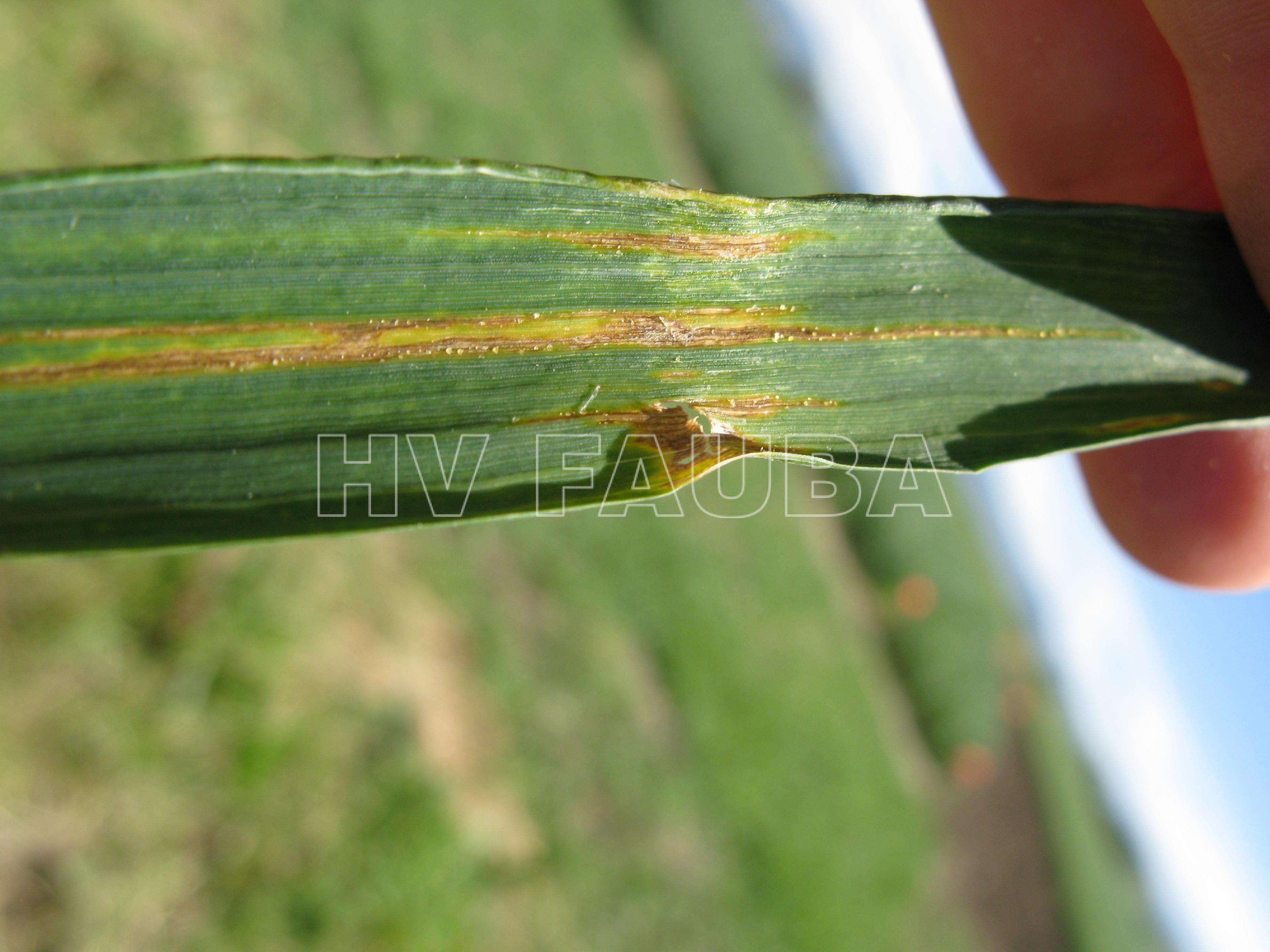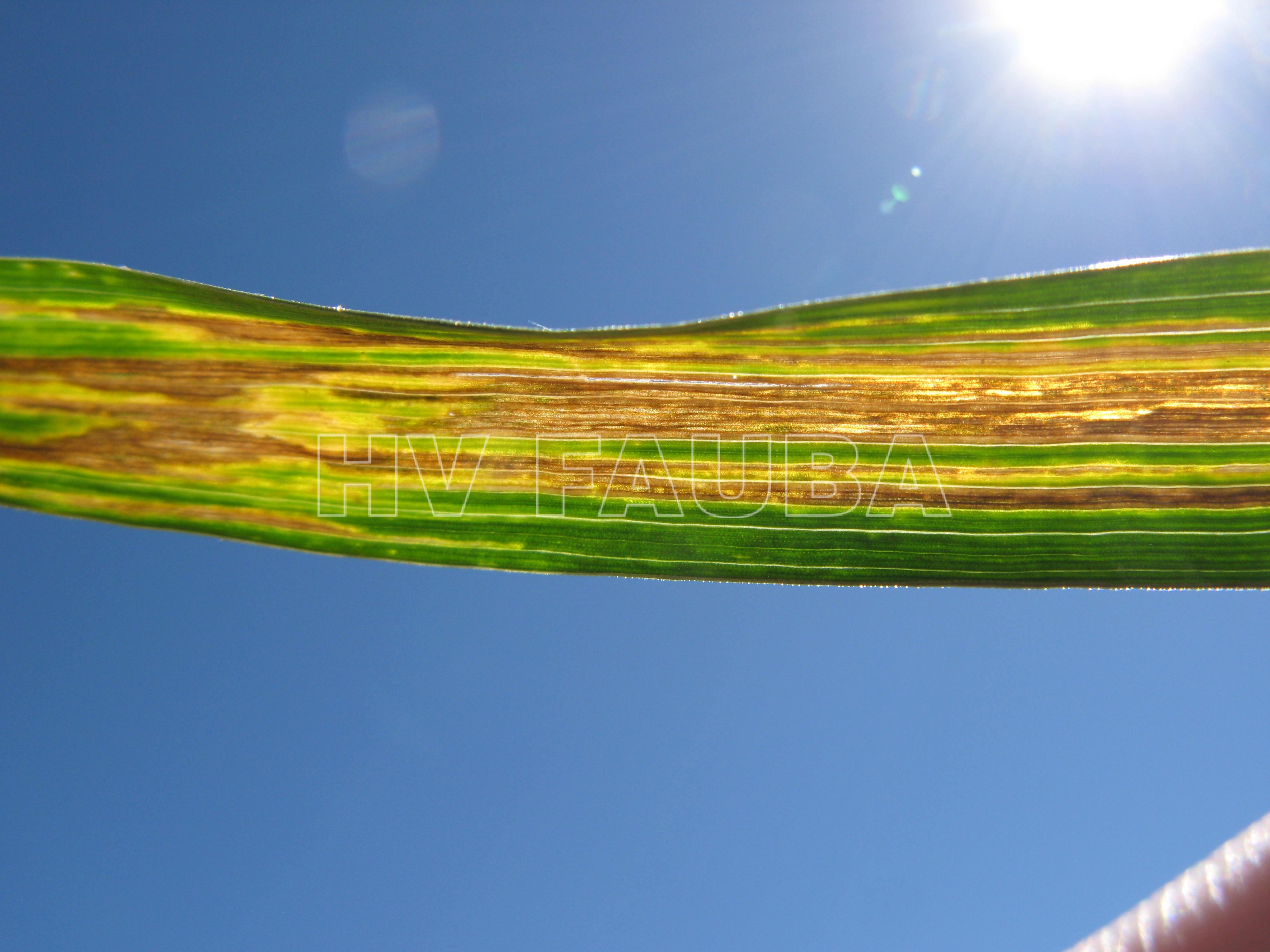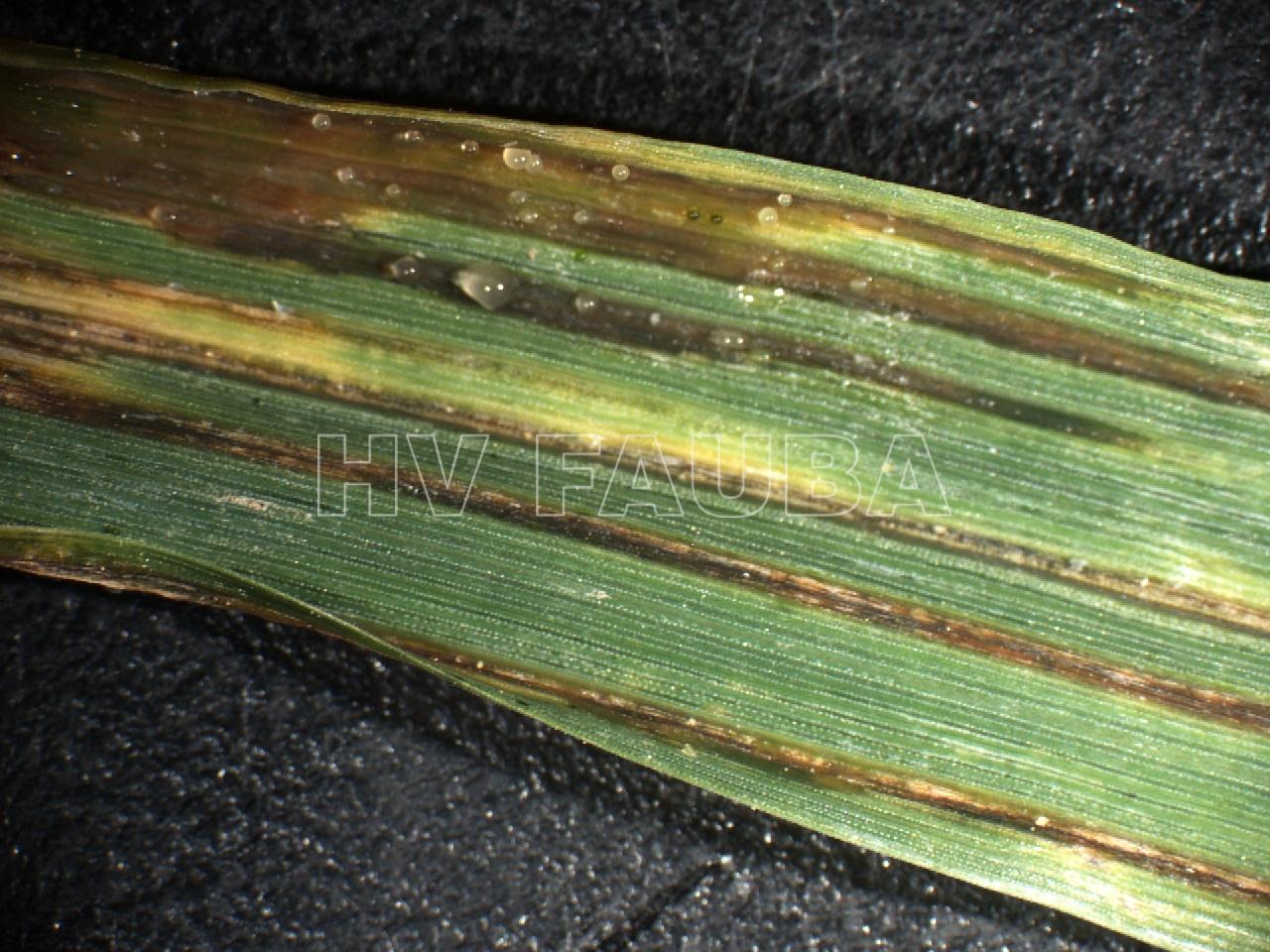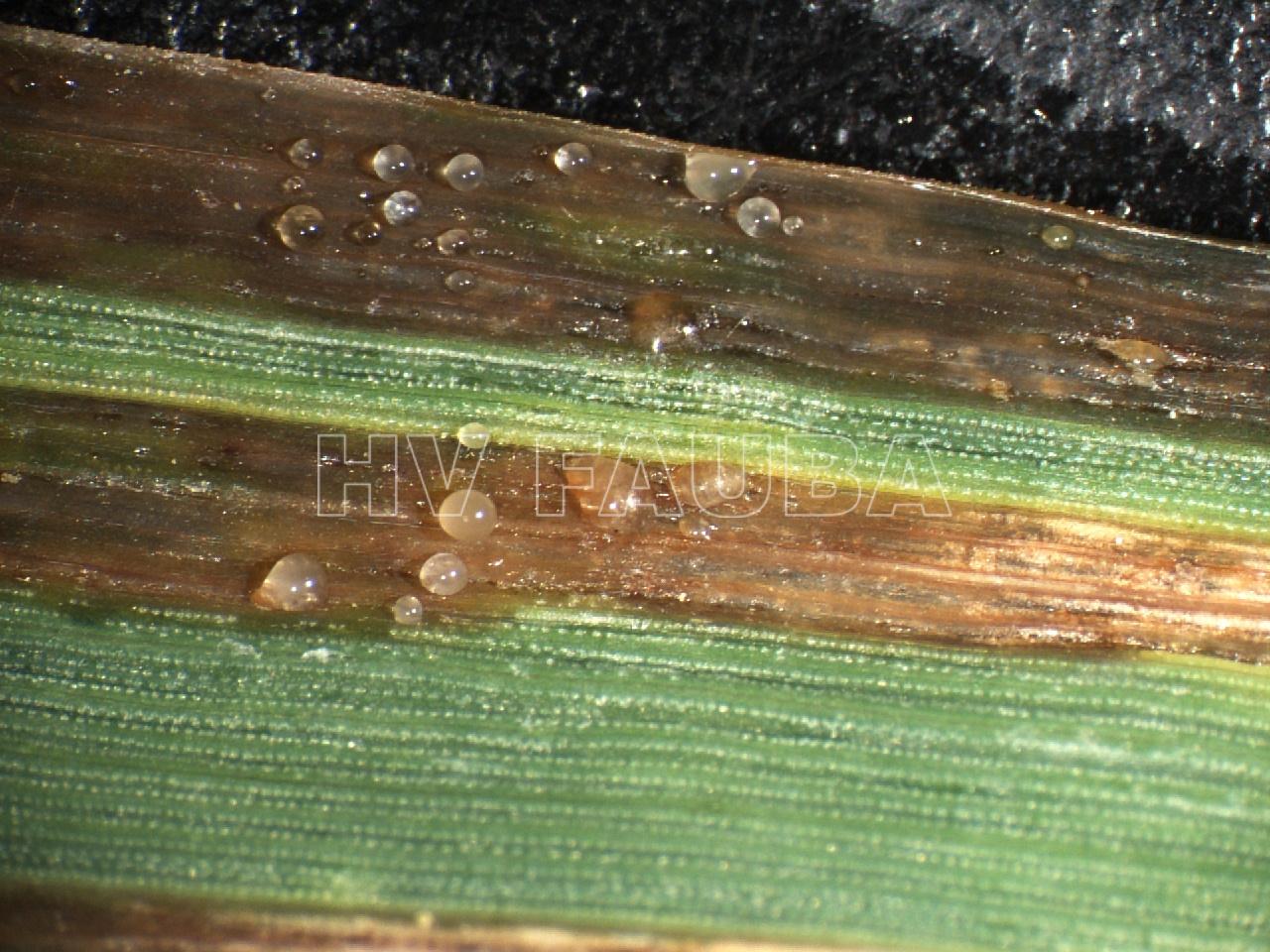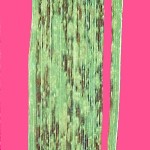.
Condición fitosanitaria: Presente solo en algunas áreas del país
Grupo de cultivos: Cereales
Especie hospedante: Trigo (Triticum aestivum)
Etiología: Bacteria. Gram negativa. Considerada hemibiotrófica
Agente causal: Xanthomonas translucens pv. undulosa (syn Xanthomonas campestris pv. undulosa)
Taxonomía: Bacteria > Proteobacteria > Gammaproteobacteria > Xanthomonadales > Xanthomonadaceae > Xanthomonas
.
.
.
Antecedentes
La importancia de la enfermedad es moderada a alta, particularmente cuando se utiliza riego suplementario. En inglés la enfermedad se conoce como «Bacterial leaf streak (BLS) of wheat».
.
Síntomas y signos
Manchas estriadas marrones sobre las hojas principalmente a partir de floración. El tallo y los granos también pueden verse afectados tomando un aspecto marrón oscuro y de apariencia húmeda. Los síntomas se hacen más evidentes en espigazón . En las hojas se producen estrías angostas marrones frecuentemente humedecidas y en las cuales, bajo condiciones de humedad, se producen exudados amarillentos. También ataca las glumas, dándole a la espiga un color oscuro. Un síntoma característico que se produce sobre las aristas son bandas de tejido necrótico alternado con sano.
.
.
- Autor: M. Burrows, publicado en Crop Protection Network
- Autor: M. Burrows, publicado en Crop Protection Network
- Autor: M. Burrows, publicado en Crop Protection Network
- Autor: M. Burrows, publicado en Crop Protection Network
.
.
Daños
En Argentina, en 1985 ocurrió una epifitia de esta enfermedad ocasionando severas pérdidas.
.
Epidemiología
Se presenta en trigo, cebada, avena centeno y otras gramíneas. Las epidemias severas son de carácter esporádico. La mayor frecuencia e incidencia de esta enfermedad, ocurre en áreas húmedas o en campos de trigo bajo riego.
Como muchos hongos necrotróficos, Xanthomonas campestris es transmitida por las semillas y sobrevive en los restos culturales. La persistencia de esta bacteria en el rastrojo depende de las temperaturas que ocurran en el verano. Con temperaturas mayores a 34 ºC, la bacteria sobreviviría no más de 5 meses. El patógeno es dispersado por gotas de lluvias, o por la aspersión en los campos bajo riego, y a través de insectos visitantes (áfidos).
.
Condiciones predisponentes
* La siembra de semillas infectadas introduce la enfermedad en campos nuevos o bajo rotación
* El monocultivo asegura la presencia indefinida del patógeno en el cultivo. Resulta más grave si se trata de un planteo de siembra directa.
* Temperatura y humedad elevadas.
* Campos bajo riego.
* Uso de cultivares susceptibles.
* Para el establecimiento de la enfermedad (infecciones primarias): Tiempo templado-cálido y lluviosos. Alta humedad relativa y temperaturas de alrededor de 20 °C.
* Para la dispersión de la enfermedad (infecciones secundarias): Frecuentes lloviznas o salpicado por gotas de riego, alta humedad relativa y temperaturas de 20 a 30 ° C.
.
Manejo Integrado
Rotación de cultivos, eliminación de otros hospedantes (gramíneas) y uso de semilla sana. Las medidas preferenciales y que deben ser llevadas a cabo complementariamente son:
* Tratamiento de semillas
* Rotación de cultivos
Otras:
Resistencia varietal: Como todo patógeno necrotrófico, la resistencia total genética no ha sido completamente desarrollada. Sin embargo pueden usarse variedades tolerantes. Otra recomendación consiste en cosechar primero los lotes no infectados y por último los enfermos con bacteriosis porque la cosechadora podría contaminar las semillas.
Los lotes de semillas provenientes de campos infectados no deberían ser usados como semillas en campos bajo riego.
.
.
.
Bibliografía
Bacterial Leaf Blight of Wheat. Crop Protection Network
Alvarez-Martinez CE, Sgro GG, Araujo GG, et al. (2020) Secrete or perish: The role of secretion systems in Xanthomonas biology. Computational and Structural Biotechnology Journal 19: 279-302. doi: 10.1016/j.csbj.2020.12.020
Catara V, Cubero J, Pothier JF, et al. (2021) Trends in Molecular Diagnosis and Diversity Studies for Phytosanitary Regulated Xanthomonas. Microorganisms 9(4): 862. doi: 10.3390/microorganisms9040862
Costa J, Pothier JF, Boch J, et al. (2021) Integrating science on Xanthomonadaceae for sustainable plant disease management in Europe. Mol Plant Pathol. 22(12): 1461-1463. doi: 10.1111/mpp.13150
Curland RD, Gao L, Hirsch CD, Ishimaru CA (2020) Localized Genetic and Phenotypic Diversity of Xanthomonas translucens Associated With Bacterial Leaf Streak on Wheat and Barley in Minnesota. Phytopathology 110(2): 257-266. doi: 10.1094/PHYTO-04-19-0134-R
Domingo-Calap ML, Bernabéu-Gimeno M, Aure MC, et al. (2022) Comparative Analysis of Novel Lytic Phages for Biological Control of Phytopathogenic Xanthomonas spp. Microbiol Spectr. e0296022. doi: 10.1128/spectrum.02960-22
Friskop A, Green A, Ransom J, et al. (2023) Increase of Bacterial Leaf Streak in Hard Red Spring Wheat in North Dakota and Yield Loss Considerations. Phytopathology 113(11): 2103-2109. doi: 10.1094/PHYTO-08-22-0282-SA
Fu H, Fleitas MC, Sarkes A, et al. (2023) Detection and differentiation of Xanthomonas translucens pathovars translucens and undulosa from wheat and barley by duplex quantitative PCR. bioRxiv 2023.03.06.531419; doi: 10.1101/2023.03.06.531419
Haq F, Xu X, Ma W, et al. (2021) A Xanthomonas transcription activator-like effector is trapped in nonhost plants for immunity. Plant Communications. doi: 10.1016/j.xplc.2021.100249
Heiden N, Broders KA, Hutin M, et al. (2023) Bacterial Leaf Streak Diseases of Plants: Symptom Convergence in Monocot Plants by Distant Pathogenic Xanthomonas Species. Phytopathology 113(11): 2048-2055. doi: 10.1094/PHYTO-05-23-0155-IA
Hong E, Bankole IA, Zhao B, et al. (2023) DNA Markers, Pathogenicity Test, and Multilocus Sequence Analysis to Differentiate and Characterize Cereal-Specific Xanthomonas translucens Strains. Phytopathology 113(11): 2062-2072. doi: 10.1094/PHYTO-10-22-0381-SA
Heiden N, Roman-Reyna V, Curland RD, et al. (2023) Comparative Genomics of Barley-Infecting Xanthomonas translucens Shows Overall Genetic Similarity but Globally Distributed Virulence Factor Diversity. Phytopathology 113(11): 2056-2061. doi: 10.1094/PHYTO-04-22-0113-SC
Ledman KE, Curland RD, Ishimaru C, Dill-Macky R (2020) Xanthomonas translucens pv. undulosa identified on common weedy grasses in naturally infected wheat fields in Minnesota. Phytopathology. doi: 10.1094/PHYTO-08-20-0337-R
Ledman KE, Osdaghi E, Curland RD, et al. (2023) Epidemiology, Host Resistance, and Genomics of the Small Grain Cereals Pathogen Xanthomonas translucens: New Advances and Future Prospects. Phytopathology 113(11): 2037-2047. doi: 10.1094/PHYTO-11-22-0403-SA
Ledman KE, Roman-Reyna V, Curland RD, et al. (2023) Comparative Genomics of Xanthomonas translucens pv. undulosa Strains Isolated from Weedy Grasses and Cultivated Wild Rice. Phytopathology 113(11): 2083-2090. doi: 10.1094/PHYTO-09-22-0352-SA
Liu Z, Friskop A, Jacobs JM, Dill-Macky R (2023) Bacterial Leaf Streak: A Persistent and Increasingly Important Disease Problem for Cereal Crops. Phytopathology 113(11): 2020-2023. doi: 10.1094/PHYTO-11-23-0423-SA
, , , The Arabidopsis immune receptor EFR increases resistance to the bacterial pathogens Xanthomonas and Xylella in transgenic sweet orange.
(2023) Exploring the relationship between pattern-triggered immunity and quantitative resistance to Xanthomonas vasicola pv. vasculorum in maize. Phytopathology 113: 2127-2133. doi: 10.1094/PHYTO-09-22-0357-SA
Osdaghi E, Taghavi SM, Aliabadi AA, et al. (2023) Detection and Diagnosis of Bacterial Leaf Streak on Small Grain Cereals: From Laboratory to Field. Phytopathology 113(11): 2024-2036. doi: 10.1094/PHYTO-09-22-0343-SA
Ramakrishnan SM, Sidhu JS, Ali S, et al. (2019) Molecular characterization of bacterial leaf streak resistance in hard winter wheat. PeerJ. 7: e7276. doi: 10.7717/peerj.7276
Ritzinger M, Sallam AH, Smith KP, et al. (2023) Genome-Wide Association Mapping of Bacterial Leaf Streak Resistance in Two Elite Barley Breeding Panels. Phytopathology 113(11): 2119-2126. doi: 10.1094/PHYTO-10-22-0402-SA
Román-Reyna V, Curland RD, Velez-Negron Y, et al. (2023) Development of Genome-Driven, Lifestyle-Informed Markers for Identification of the Cereal-Infecting Pathogens Xanthomonas translucens Pathovars undulosa and translucens. Phytopathology 113(11): 2110-2118. doi: 10.1094/PHYTO-07-22-0262-SA
Ryan RP, Vorhölter FJ, Potnis N, et al. (2011) Pathogenomics of Xanthomonas: understanding bacterium-plant interactions. Nature Reviews Microbiology 9(5): 344–355. doi: 10.1038/nrmicro2558
Sapkota S, Zhang Q, Chittem K, et al. (2017) Evaluation of triticale accessions for resistance to wheat bacterial leaf streak caused by Xanthomonas translucens pv. undulosa. Plant Patholology (accepted). doi: 10.1111/ppa.12768
Shah SMA, Khojasteh M, Wang Q, et al. (2023) Comparative Transcriptomic Analysis of Wheat Cultivars in Response to Xanthomonas translucens pv. cerealis and Its T2SS, T3SS, and TALEs Deficient Strains. Phytopathology 113(11): 2073-2082. doi: 10.1094/PHYTO-02-23-0049-SA
Tambong JT, Xu R, Fleitas MC, et al. (2023) Phylogenomic Insights on the Xanthomonas translucens Complex, and Development of a TaqMan Real-Time Assay for Specific Detection of pv. translucens on Barley. Phytopathology 113(11): 2091-2102. doi: 10.1094/PHYTO-01-23-0022-SA
Vieira PS, Bonfim IM, Araujo EA, et al. (2021) Xyloglucan processing machinery in Xanthomonas pathogens and its role in the transcriptional activation of virulence factors. Nat Commun 12: 4049. doi: 10.1038/s41467-021-24277-4
Teper D, White FF, Wang N (2023) The Dynamic Transcription Activator-Like Effector Family of Xanthomonas. Phytopathology 113(4): 651-666. doi: 10.1094/PHYTO-10-22-0365-KD
